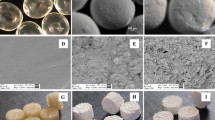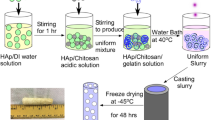Abstract
Glutaraldehyde (GA), the most widely used crosslinking agent for biomaterials, is cytotoxic. CaCl2 is of particular interest due to its non-toxic nature. Rhein can chelate Ca2+ and promote bone growth. Here we reported a novel nano calcium-deficient hydroxyapatite/O-carboxymethyl chitosan-CaCl2 microspheres loaded with rhein (RH-nCDHA/OCMC-CaCl2 microspheres) using CaCl2 as crosslinking agent for bone defect repair. The obtained microspheres were characterized by X-ray diffraction (XRD), scanning electron microscopy (SEM), thermogravimetric analysis (TG) and Fourier transform infrared spectroscopy (FT-IR). The surface of the obtained microspheres is rough with quite a few voids. The nano calcium-deficient hydroxyapatite (nCDHA) accounts for about 70% of the total weight of the microspheres, which is equivalent to the proportion of inorganic substances in human bones. A high encapsulation efficiency (EE) and loading capacity (LC) of the microspheres loaded with rhein was 90.20 ± 0.60% and 11.03 ± 0.30%, respectively. For microspheres using CaCl2 in simulated body fluid (SBF) after 14 days, the drug released continuously and bone-like apatite formed like layer. The cells on the surface of the RH-nCDHA/OCMC-CaCl2 microspheres grew better comparing with nCDHA/OCMC-GA microspheres and the skull defects of rats after landfill can be almost repaired after 8 weeks, which revealed the potential of the microspheres for bone repair.











Similar content being viewed by others
References
Rozalia, D., Elena, J., Dennis, M., & Peter, V. (2011). Bone regeneration: Current concepts and future directions. BMC Medicine, 9(1), 66.
Campana, V., Milano, G., Pagano, E., Barba, M., Cicione, C., Salonna, G., Lattanzi, W., & Logroscino, G. (2014). Bone substitutes in orthopaedic surgery: From basic science to clinical practice. Journal of Materials Science. Materials in Medicine, 25(10), 2445–2461.
Sánchez-Ferrero, A., Mata, Á., Mateos-Timoneda, M. A., Rodríguez-Cabello, J. C., Alonso, M., Planell, J., & Engel, E. (2015). Development of tailored and self-mineralizing citric acid-crosslinked hydrogels for in situ bone regeneration. Biomaterials, 68, 42–53.
Chen, G. Q., Deng, C. X., & Li, Y. P. (2012). TGF-β and BMP signaling in osteoblast differentiation and bone formation. International Journal of Biological Sciences, 8(2), 272–288.
Han, G., Su, J., Jie, W., Kong, H., & Liu, C. (2009). Biocompatibility and osteogenicity of degradable Ca-deficient hydroxyapatite scaffolds from calcium phosphate cement for bone tissue engineering. Acta Biomaterialia, 5(1), 268–278.
Winand, L., & Dallemagne, M. J. (1962). Hydrogen bonding in the calcium phosphates. Nature, 193(4813), 369–370.
Yu, M., Zhou, K., Li, Z., & Zhang, D. (2014). Preparation, characterization and in vitro gentamicin release of porous HA microspheres. Materials Science and Engineering C, 45, 306–312.
Lee, J., & Kim, G. (2018). Calcium-deficient hydroxyapatite/collagen/platelet-rich plasma scaffold with controlled release function for hard tissue regeneration. ACS Biomaterials Science & Engineering, 4(1), 278–289.
Zhao, J., Wang, S. Y., Bao, J. Q., Sun, X. J., Zhang, X. C., Zhang, X. L., Ye, D. X., Wei, J., Liu, C. S., Jiang, X. Q., Shen, G., & Zhang, Z. Y. (2013). Trehalose maintains bioactivity and promotes sustained release of BMP-2 from lyophilized CDHA scaffolds for enhanced osteogenesis in vitro and in vivo. PLoS ONE, 8(1), e54645.
Liu, T. Y., Chen, S. Y., Li, J. H., & Liu, D. M. (2006). Study on drug release behaviour of CDHA/chitosan nanocomposites-effect of CDHA nanoparticles. Journal of Controlled Release, 112(1), 88–95.
Paul, W., & Sharma, C. P. (1999). Development of porous spherical hydroxyapatite granules: Application towards protein delivery. Journal of Materials Science. Materials in Medicine, 10(7), 383–388.
Wei, P. F., Yuan, Z. Y., Jing, W., Guan, B. B., Liu, Z. H., Zhang, X., Mao, J. P., Chen, D. F., Cai, Q., & Yang, X. P. (2019). Regenerating infected bone defects with osteocompatible microspheres possessing antibacterial activity. Biomater Sci, 7(1), 272–286.
Reddy, N., Reddy, R., & Jiang, Q. R. (2015). Crosslinking biopolymers for biomedical applications. Trends in Biotechnology, 33(6), 362–369.
Hennink, W. E., & van Nostrum, C. F. (2012). Novel crosslinking methods to design hydrogels. Adv Drug Del Rev, 64, 223–236.
Slezak, P., Klang, A., Ferguson, J. C., Schmidt, P., & Gulle, H. (2019). Tissue reaction to a polyethylene glycol-based and glutaraldehyde-based surgical sealant in a rabbit aortic anastomosis model. Journal of the American College of Surgeons, 229(4), e211–e212.
Fukunaga, N., Matsuo, T., Saji, Y., Imai, Y., & Koyama, T. (2015). Mitral valve stenosis progression due to severe calcification on glutaraldehyde-treated autologous pericardium: Word of caution for an attractive repair technique. Annals of Thoracic Surgery, 99(6), 2203–2205.
Kalliola, S., Repo, E., Srivastava, V., Heiskanen, J. P., Sirviö, J. A., Liimatainen, H., & Sillanpää, M. (2017). The pH sensitive properties of carboxymethyl chitosan nanoparticles cross-linked with calcium ions. Coll Surf B Biointerf, 153, 229–236.
Anitha, A., Maya, S., Deepa, N., Chennazhi, K. P., Nair, S. V., Tamura, H., & Jayakumar, R. (2011). Efficient water soluble O-carboxymethyl chitosan nanocarrier for the delivery of curcumin to cancer cells. Carbohydrate Polymers, 83(2), 452–461.
You, X., Feng, S., Luo, S. L., Cong, D. D., Yu, Z. W., Yang, Z. R., & Zhang, J. (2013). Studies on a rhein-producing endophytic fungus isolated from Rheum palmatum L. Fitoterapia, 85, 161–168.
Xu, X., Qi, X. Y., Yan, Y. F., Qi, J., Qian, N. D., Guo, L., Li, C. W., Wang, F., Huang, P., Zhou, H. B., Jiang, M., Yang, C. H., & Deng, L. F. (2016). Synthesis and biological evaluation of rhein amides as inhibitors of osteoclast differentiation and bone resorption. European Journal of Medicinal Chemistry, 123, 769–776.
Wang, Y., Li, L. Z., Zhang, Y. L., Sun, W. J., Zhu, Y. Q., Cui, Y., & Qi, L. (2011). LC, a novel estrone–rhein hybrid compound, promotes proliferation and differentiation and protects against cell death in human osteoblastic MG-63 cells. Molecular and Cellular Endocrinology, 344(1), 59–68.
Wang, Y., Li, L. Z., Zhang, Y. L., Zhu, Y. Q., Wu, J., & Sun, W. J. (2011). LC, a novel estrone–rhein hybrid compound, concurrently stimulates osteoprotegerin and inhibits receptor activator of NF-κB ligand (RANKL) and interleukin-6 production by human osteoblastic cells. Molecular and Cellular Endocrinology, 337(1), 43–51.
Sambudi, N. S., Cho, S., & Cho, K. (2016). Porous hollow hydroxyapatite microspheres synthesized by spray pyrolysis using a microalga template: Preparation, drug delivery, and bioactivity. RSC Advances, 6(49), 43041–43048.
Li, H. Y., Li, J. Y., & Ye, J. D. (2016). Construction and properties of poly( lactic-co-glycolic acid )/calcium phosphate cement composite pellets with microspheres-in-pellet structure for bone repair. Ceramics International, 42(4), 5587–5592.
Ji, J. G., Ran, J. G., Gou, L., Wang, F. H., Chen, S. Q., & Fu, X. N. (2003). Study on the preparation of HA/ beta TCP biphasic bioceramics powder by coprecipitation. Journal of Functional Materials, 34(5), 597–599.
Wang, K., Wang, Y. J., Zhao, X., Li, Y., Yang, T., Zhang, X., & Wu, X. G. (2017). Sustained release of simvastatin from hollow carbonated hydroxyapatite microspheres prepared by aspartic acid and sodium dodecyl sulfate. Materials Science and Engineering C, 75, 565–571.
Izadpanah, R., Trygg, C., Patel, B., Kriedt, C., Dufour, J., Gimble, J. M., & Bunnell, B. A. (2006). Biologic properties of mesenchymal stem cells derived from bone marrow and adipose tissue. Journal of Cellular Biochemistry, 99(5), 1285–1297.
Huang, K.-C., Yano, F., Murahashi, Y., Takano, S., Kitaura, Y., Chang, S. H., Soma, K., Ueng, S. W. N., Tanaka, S., Ishihara, K., Okamura, Y., Moro, T., & Saito, T. (2017). Sandwich-type PLLA-nanosheets loaded with BMP-2 induce bone regeneration in critical-sized mouse calvarial defects. Acta Biomaterialia, 59, 12–20.
Zhang, W., Yu, Z. L., Wu, M., Ren, J. G., Xia, H. F., Sa, G. L., Zhu, J. Y., Pang, D. W., Zhao, Y. F., & Chen, G. (2017). Magnetic and folate functionalization enables rapid isolation and enhanced tumor-targeting of cell-derived microvesicles. ACS Nano, 11(1), 277–290.
Petite, H., Duval, J.-L., Frei, V., Abdul-Malak, N., Sigot-Luizard, M.-F., & Herbage, D. (1995). Cytocompatibility of calf pericardium treated by glutaraldehyde and by the acyl azide methods in an organotypic culture model. Biomaterials, 16(13), 1003–1008.
Yilmaz, B., Pazarceviren, A. E., Tezcaner, A., & Evis, Z. (2020). Historical development of simulated body fluids used in biomedical applications: A review. Microchemical Journal, 155, 104713.
Acknowledgements
The authors would like to express their heartfelt gratitude to Professor J. Ji, who has offered valuable suggestions in the academic studies. Moreover, the various instrumental analysis of the Analytical and Testing Center of Chongqing University.
Author information
Authors and Affiliations
Corresponding authors
Ethics declarations
Conflict of interest
There are no conflicts to declare.
Additional information
Publisher's Note
Springer Nature remains neutral with regard to jurisdictional claims in published maps and institutional affiliations.
Rights and permissions
About this article
Cite this article
Tian, Z., Guo, Y., Yang, X. et al. Nano Calcium-Deficient Hydroxyapatite/O-carboxymethyl Chitosan-CaCl2 Microspheres Loaded with Rhein for Bone Defect Repair. J Bionic Eng 19, 1087–1099 (2022). https://doi.org/10.1007/s42235-022-00179-z
Received:
Revised:
Accepted:
Published:
Issue Date:
DOI: https://doi.org/10.1007/s42235-022-00179-z




